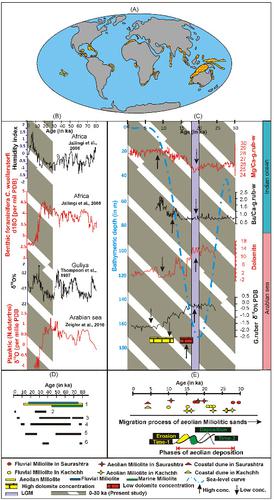当前位置:
X-MOL 学术
›
Earth Surf.Process. Land.
›
论文详情
Our official English website, www.x-mol.net, welcomes your
feedback! (Note: you will need to create a separate account there.)
Late‐Quaternary miliolite (biogenic carbonate) deposits and their implications for sea‐level fluctuations and climatic variability
Earth Surface Processes and Landforms ( IF 2.8 ) Pub Date : 2021-01-15 , DOI: 10.1002/esp.5067 A. Durga Prasad 1, 2 , Falguni Bhattacharya 1 , Gaurav Chauhan 3 , D. Balaji 4 , M.G. Thakkar 3 , Y. Srinivasa Rao 2
Earth Surface Processes and Landforms ( IF 2.8 ) Pub Date : 2021-01-15 , DOI: 10.1002/esp.5067 A. Durga Prasad 1, 2 , Falguni Bhattacharya 1 , Gaurav Chauhan 3 , D. Balaji 4 , M.G. Thakkar 3 , Y. Srinivasa Rao 2
Affiliation

|
The western coast of India (Kachchh) has ubiquitous preservations of Quaternary carbonate deposits popularly known as “miliolites”. Field‐based detail documentation of the nature and distribution of miliolites supported by sedimentology and scanning electron microscopy (SEM) microtextural studies indicates that the miliolites were primarily deposited by wind as aeolinites and are termed “primary miliolites (PM)”. These were subsequently fluvially eroded and deposited and such deposits are termed “secondary miliolites (SM)”. The PM are dated between 28 ka to 16 ka largely clustering around the Last Glacial Maxima (LGM). In comparison, the fluvially reworked SM occurs as valley‐fill deposits and were deposited episodically during 23 ka to 10 ka before present. Climatically, the deposition of PMs suggests enhanced aridity whereas SMs represent episodic strengthening of the Indian Summer Monsoon (ISM). The bedding attitudes of the PMs indicate that they were deposited predominantly by the northeasterly winds whereas the presence of the deflation lag deposits suggests downwind migration of sands during the equilibrium condition (reduced sediment supply). The aeolian parameters (based on the grain size and wind velocities) for PMs indicate high shear velocity (~23 to 48 cm−1) and high transport rate (< 0.1 to 0.2 g/cm s). The short average flying distance implies that the biogenic sands were transported in multiple pulses (from coast to inland) at rates varying from ~200 m/h to ~1 km/h. Comparing our data with related occurrences along the biologically productive coasts in the mid‐latitudinal belt indicates that the regional/global aridity during the lowered sea level was responsible for inland occurrences of aeolinites, particularly during the LGM. The strengthened northeast monsoon winds during the LGM was conducive to upwelling and production of biogenic carbonates along the coasts. The subsequent reworking of the aeolinites were mainly the results of local variability in precipitation.
中文翻译:

第四纪晚闪长岩(生物碳酸盐)沉积及其对海平面波动和气候变化的影响
印度西海岸(Kachchh)普遍存在着第四纪碳酸盐矿床的保存,人们普遍称其为“ Miliolites”。沉积学和扫描电子显微镜(SEM)微观结构研究支持的基于云母的性质和分布的野外详细文档显示,该云母主要是风沉积为风铁石,被称为“原生硅铁矿(PM)”。这些随后被河流侵蚀和沉积,这种沉积物被称为“次生粟粒岩(SM)”。PM的日期介于28 ka至16 ka之间,主要集中在最后冰川最大区(LGM)周围。相比之下,经过河流改造的SM以谷底沉积物的形式出现,并在23 ka至10 ka之前呈沉积状沉积。在气候上 PM的沉积表明干旱增强,而SM则代表印度夏季风(ISM)的偶发增强。PM的层理态度表明它们主要是由东北风沉积的,而放气滞后沉积物的存在则表明在平衡条件下沙粒的顺风迁移(沉积物供应减少)。PM的风沙参数(基于晶粒度和风速)表明剪切速度较高(〜23至48 cm)-1)和高传输速率(<0.1至0.2 g / cm s)。平均飞行距离短意味着生砂以多脉冲(从海岸到内陆)的速度运输,速度从〜200 m / h到〜1 km / h不等。将我们的数据与中纬度带生物生产性海岸沿岸的相关事件进行比较表明,海平面下降期间的区域/全球干旱是内陆风钙石发生的原因,特别是在LGM时期。LGM期间东北季风增强,有利于沿海岸上升和生产生物碳酸盐。随后的风化岩的返工主要是降水局部变化的结果。
更新日期:2021-01-15
中文翻译:

第四纪晚闪长岩(生物碳酸盐)沉积及其对海平面波动和气候变化的影响
印度西海岸(Kachchh)普遍存在着第四纪碳酸盐矿床的保存,人们普遍称其为“ Miliolites”。沉积学和扫描电子显微镜(SEM)微观结构研究支持的基于云母的性质和分布的野外详细文档显示,该云母主要是风沉积为风铁石,被称为“原生硅铁矿(PM)”。这些随后被河流侵蚀和沉积,这种沉积物被称为“次生粟粒岩(SM)”。PM的日期介于28 ka至16 ka之间,主要集中在最后冰川最大区(LGM)周围。相比之下,经过河流改造的SM以谷底沉积物的形式出现,并在23 ka至10 ka之前呈沉积状沉积。在气候上 PM的沉积表明干旱增强,而SM则代表印度夏季风(ISM)的偶发增强。PM的层理态度表明它们主要是由东北风沉积的,而放气滞后沉积物的存在则表明在平衡条件下沙粒的顺风迁移(沉积物供应减少)。PM的风沙参数(基于晶粒度和风速)表明剪切速度较高(〜23至48 cm)-1)和高传输速率(<0.1至0.2 g / cm s)。平均飞行距离短意味着生砂以多脉冲(从海岸到内陆)的速度运输,速度从〜200 m / h到〜1 km / h不等。将我们的数据与中纬度带生物生产性海岸沿岸的相关事件进行比较表明,海平面下降期间的区域/全球干旱是内陆风钙石发生的原因,特别是在LGM时期。LGM期间东北季风增强,有利于沿海岸上升和生产生物碳酸盐。随后的风化岩的返工主要是降水局部变化的结果。











































 京公网安备 11010802027423号
京公网安备 11010802027423号